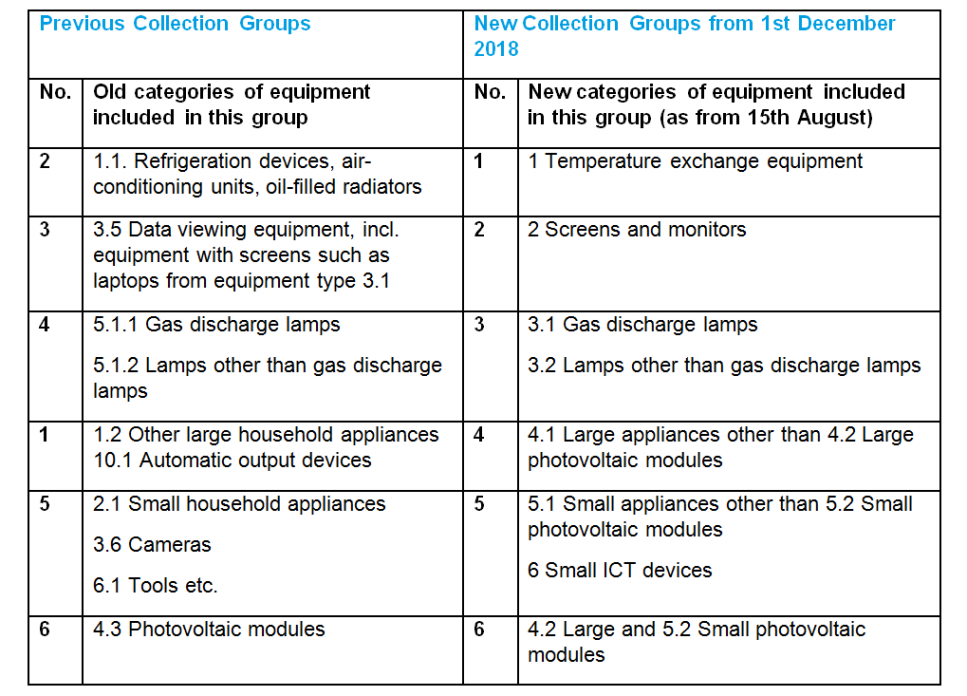Everything remains different: The new structure of the collection groups and the Open Scope – guest article by Axel Riemann, NOEX AG
The regulation on waste electrical and electronic equipment
For over a decade, manufacturers and municipal waste disposal authorities have been sharing the responsibility for collecting and disposing of waste electrical and electronic equipment. The goal of the law “on bringing electrical and electronic equipment into circulation, taking it back and disposing of it in an environmentally friendly way” – or the ElektroG, for short – which was first released in 2005, is to ensure that making electrical equipment is as environmentally friendly and sustainable as possible.
The revision of the ElektroG: the Open Scope
Like most legal rules and regulations, the ElektroG has been repeatedly modified and amended over the years. The last major modification was launched in October 2015 – whereby the version introduced at the time was interwoven with far-reaching changes to the wording of the law, which were to come into force in 2018:
Hence up until 14th August 2018, the law only applied to certain types of electrical and electronic equipment, as explicitly listed in § 2. As of 15th August 2018, however, the law now applies to all types of electrical and electronic equipment, unless specifically exempt from it. The aim of this European-wide “Open Scope” is to also register all the types of equipment that have until now “fallen by the wayside” and whose disposal has therefore hitherto not been clearly regulated. This ultimately means that wardrobes, blinking trainers and hospital beds will in future be covered by the law too. And it means that these new types of equipment will in future have to be collected along with such “classical” equipment as washing machines and Refrigerators.
Because in all these years, the one thing that has not changed is that manufacturers and municipal authorities share the responsibility for these products. In this system, manufacturers are responsible for the ultimate disposal of the waste electrical and electronic equipment (and the cost associated with this), while the municipal authorities are in charge of collecting the waste equipment owned by citizens. Here too, though, a great deal has changed – though in the medium term this will be to the advantage of everyone involved.
The new collection groups at municipal collection facilities
Until now, waste electrical and electronic equipment has been assigned to 10 different categories, which were however only collected by the municipal authorities in just 6 different collection groups for disposal. The assignment of waste electrical and electronic equipment to the different collection groups was not logically structured, and in several cases the groups overlapped.
This has now changed in the revised version of the law. Since 15 August 2018, there have only been 6 categories, which from 1st December 2018 on (that is how long the municipal authorities have been given to adjust to the changes) will also be collected in just 6 collection groups (see figure below). Unfortunately, the overlap between categories and collection groups has not been entirely eliminated by these revisions (e.g. 5.1 Small equipment and 6. Small ICT devices are being merged into Collection Group 5). Nevertheless, the revision of the collection groups is a step in the right direction and should – once everyone has got used to the changes – contribute to making the ElektroG system appreciably simpler.

What is changing for manufacturers?
So what is actually going to change for you as a manufacturer? weee full-service has already provided detailed information about the automatic transfer procedure. In order to ensure that waste electrical and electronic equipment continues to be disposed of correctly, manufacturers also need to check their ear registration and see whether the right disposal contractors have been assigned to the new categories. This is because not all disposal contractors are able to handle all collection groups. The staff at weee full-service will be happy to help you make these adjustments simply and quickly. Customers of the weee full-service who have already booked its reporting service do not need to take any action. For such companies, the adjustments are already included in the service.
Higher disposal costs to be expected
There is one consequence that we cannot avoid, however: The change in the composition of the new collection groups and the Open Scope of the law means that disposal contractors will have to go to more trouble and the value of the waste electrical and electronic equipment will decrease. For example, distinctly more waste electrical and electronic equipment will be classified as hazardous and will therefore have to be disposed of in accordance with the complex ADR regulations. We disposal subcontractors are therefore expecting the cost of disposal to increase. In addition, there will be additional burdens, such as higher toll fees, so that it is inevitable that our prices will need to be adjusted.
Despite this, we can continue to offer good terms and conditions for product disposal, so that we will continue to issue credit vouchers for some collection groups.
Conclusions
The switch to the Open Scope system and the changes in the collecting and registration procedures associated with this are not rocket science. At the same time, though, they ensure that waste electrical and electronic equipment can continue to be disposed of in an environmentally friendly and sustainable way, and that the planet we leave our children is clean and a pleasure to live on.
